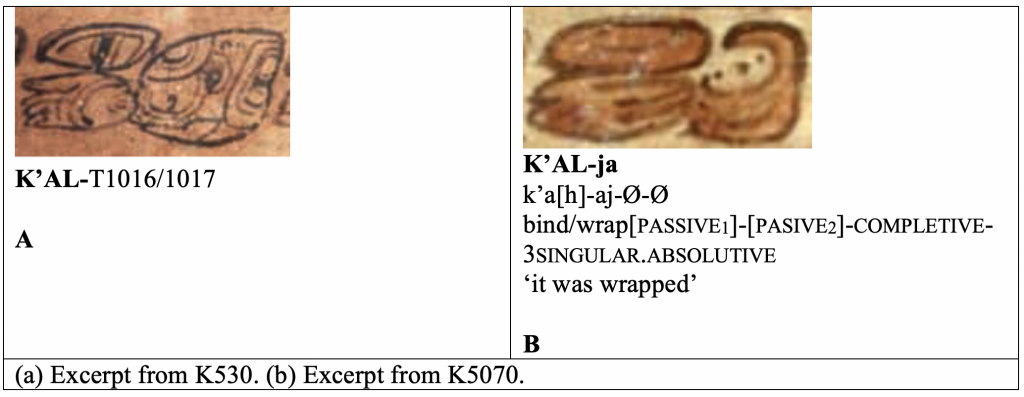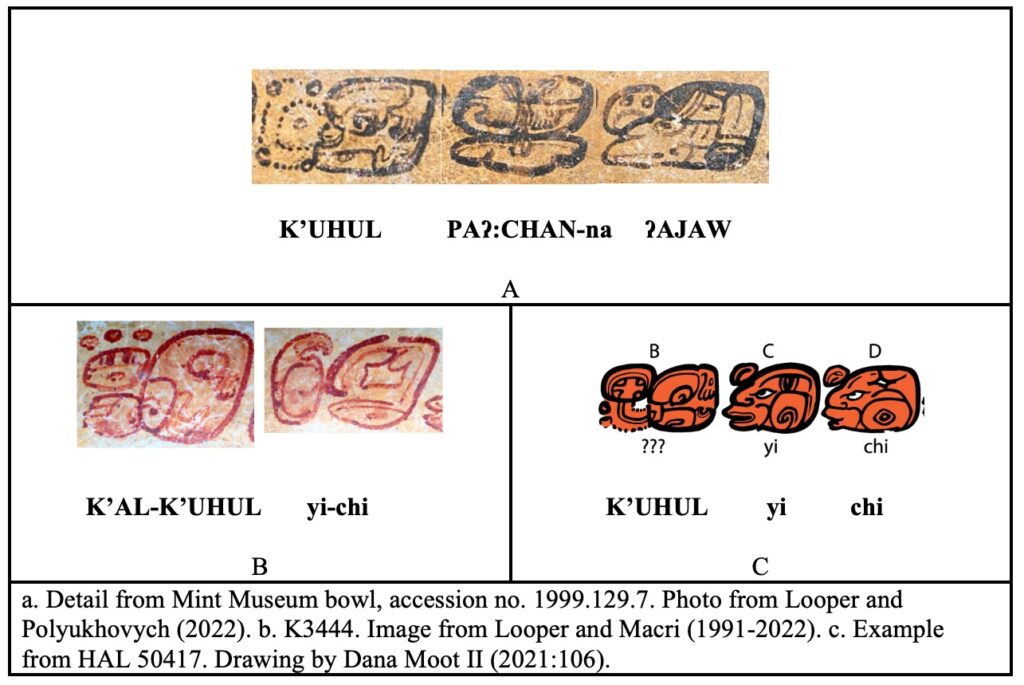Update to Note 1: More Evidence for the K’UH(UL)-yi ‘It became holy’ Verbal Expression in the PSS
David F. Mora-Marín
davidmm@unc.edu
University of North Carolina
Chapel Hill
7/4/2022
Resumen. En la Nota 1 de esta serie (Mora-Marín 2020) se propuso que la expresión verbal basada en un signo semejante al signo T1017 de Thompson (1962) podría ser una variante gráfica de T1016 K’UH(UL) ‘dios/sagrado’, y que con el sufijo -Vy ‘incoativo’, representado parcialmente por el signo T17 yi, podría representar la expresión k’uhul-uy-i-Ø ‘fue bendecido/a’. Sin embargo, un problema importante para tal propuesta lo era el hecho de que en aquel entonces no conocía de evidencia de substitución directa entre T1017 y T1016 en otros contextos. Sin embargo, tal evidencia ha salido a luz finalmente, gracias a Looper y Polyukhovych (2022), y ésta sugiere que T1017 y T1016 fueron variantes gráficas del mismo grafema en la tradición escribal de El Zotz. Esta expresión verbal provee evidencia directa y explícita de que por lo menos algunos objetos portátiles de lujo fueron manipulados ritualmente, de hecho, bendecidos.
In the first Note of this series (Mora-Marín 2020), I proposed that a somewhat common collocation on PSS texts on pottery vessels, one characterized by a main sign resembling T1017, which in turn resembles T1016 K’UH(UL) ‘god(ly)’, was meant to be read K’UH(UL)-yi (or CH’UH(UL)-yi) for k’uhul-uy-i-Ø (or ch’uhul-uy-i) ‘it became holy’. However, the main problem in further testing this reading lies in the fact that T1017, a relatively rare sign, does not seem to substitute for T1016 K’UH(UL) ‘god(ly)’ in other contexts, but merely resembles it. Here I review new evidence in favor of the proposed reading T1017 as a logogram K’UH(UL) outside of the verbal expression context. But first, I provide a review of the original evidence I presented in its favor.
As recounted in Note 1, Grube and Schele (1991:2) in fact described T1017 as a “pseudo-God C head” or a “God C variant”; they also proposed a reading TZUK ‘partition’, which Stuart (2001: 22, footnote 2; 2005:67, footnote 20) has argued to be invalid. Also, MacLeod (1990:97-98, 508) and Zender (2000:1040) suggested a syllabographic value ja based on examples, such as Figure 1a, where it is juxtaposed to the FLAT.HAND logogram in the PSS, i.e. K’AL ‘to bind, wrap’, seemingly in substitution for T181/ZU1 ja, typically used to partially spell the bipartite passive morpheme -h-…-aj to yield k’ahl-aj ‘to be wrapped/bound’.
Figure 1
Again, in Note 1 I presented evidence that T1017 functions as a separate logogram, one which may occur in its own glyph block, with or without a nearby K’AL-ja collocation. The difference is that when it does occur in its own glyph block, it typically does so with a preposed T41 K’UH(UL) ‘god(ly)’ grapheme plus a following syllabographic sequence yi-chi, resulting in K’UH(UL)-T1017 yi-chi (Figure 2), which I take to be a verbal expression, and which I have analyzed as k’uhul-uy-i-Ø+ich (holy-INCHOATIVE-COMPLETIVE-3SINGULAR.ABSOLUTIVE+ALREADY/INDEED) ‘it became holy (already/indeed)’. As already mentioned, the main obstacle to validating this reading and analysis is the fact that T1017, with or without a preceding T41, does not seem to be used with a value K’UH(UL) elsewhere.
Figure 2
To complete the recap, in Note 1 I also observed that it is not just T1017 that can become compacted within the same glyph block as T713 K’AL. This is also the case with the GOD.N verbal expression, which also loses any syllabographic signs used to spell necessary verbal markings, as seen in Figure 3a, compared to cases where the two verbal expressions are rendered in their own, separate glyph blocks, as seen in Figure 3b. In fact, Looper et al. (2022) have proposed a grapheme labeled as PJ8 which also constitutes another example of two compacted verbal expressions in the PSS, which I will address in a separate paper. For now, what matters is that T713 K’AL could be compacted with other verbal logograms, and in the process, it and the following verbal logogram are both left without space to represent, partially, much less in full, any verbal suffixes that were needed.
Figure 3
Now that the basic facts have been reviewed, I can turn to the main point of this note: I have since found at least one good example wherein T41.1017 substitutes, in fact, for the T41:1016 K’UHUL ‘godly’. This example is found, like all cases of T1017 used as a verbal expression, on an El Zotz-style vessel, specifically a bowl at the Mint Museum recently published by Looper and Polyukhovych (2022). As the example in Figure 4a shows, T1017 appears in the title phrase of an individual, more specifically, the El Zotz Emblem Glyph sequence, k’uhul paʔ chan ʔajaw, substituting for the more common T41(.1016) K’UHUL. The examples in Figures 4b–c illustrate the same grapheme in use in the verbal expressions (T1017-yi-chi) on El Zotz-style pots. This equivalence establishes that at least in El Zotz-style PSS texts, T1017 and T1016 were equivalent, perhaps stylistic variants.
Figure 4
And now, to conclude, I renew my proposed reading of the full expression K’UH(UL)-yi-chi as representing k’uh(ul)-uy-i/Ø-Ø+ich god(ly)-INCHOATIVE-COMPLETIVE-3SINGULAR.ABSOLUTIVE+ALREADY ‘it became holy already/really’. It would appear that this was a common expression in El Zotz-style PSS texts, and rare elsewhere. It would also appear that it is distinct, lexically, from the other PSS verbal expressions, to which it is occasionally juxtaposed. And last, it strongly suggests that portable objects were actually blessed, as one of the final steps in the process of preparation prior to exchange or gifting.
References
Grube, Nikolai, and Linda Schele. 1991. Tzuk in the Classic Maya Inscriptions. Texas Notes on Precolumbian Art, Writing, and Culture, 14. Art Department, University of Texas at Austin.
Houston, Stephen D., John Robertson, and David S. Stuart. 2000. The Language of Classic Maya Inscriptions. Current Anthropology 41:321-356.
Kaufman, Terrence, with John Justeson. 2003. Preliminary Mayan Etymological Dictionary. http://www.famsi.org/reports/01051/index.html.
Laughlin, Robert M., and John B. Haviland. 1988. The Great Tzotzil Dictionary of Santo Domingo Zinacantán. Smithsonian Contributions to Anthropology No. 31. Washington, D.C.: Smithsonian Institution Press.
Looper, Matthew G. and Martha J. Macri. 1991-2022. Maya Hieroglyphic Database. Department of Art and Art History, California State University, Chico. URL: http://www.mayadatabase.org/.
Looper, Matthew, and Yuriy Polyukhovych. 2016. Five Inscribed El Zotz-Style Vessels in the Fralin Museum of Art. Glyph Dwellers 45. URL: http://glyphdwellers.com/pdf/R45.pdf.
Looper, Matthew, and Yuriy Polyukhovych. 2022. Seven Inscribed Ceramic Vessels in the Mint Museum, Charlotte. Glyph Dwellers 78. URL: http://glyphdwellers.com/pdf/R78.pdf.
MacLeod, Barbara. 1990. Deciphering the Primary Standard Sequence. Unpublished Ph.D. dissertation. University of Texas at Austin.
Macri, Martha J., and Matthew G. Looper. 2003. The New Catalog of Maya Hieroglyphs, Volume One, The Classic Period Inscriptions. Norman: University of Oklahoma Press.
Moot, Dana, II. 2021. Smoking Monkeys, Drunken Jaguars: A Formal Study of El Zotz-Style Cermics. MA thesis, California State University, Chico.
Mora-Marín, David F. 2007. The Identification of an Ingressive Suffix in Classic Lowland Mayan Texts. In Proceedings of the CILLA III Conference, October 2007, Austin, Texas, edited by Nora England, pp 1-14. Austin: Archive of the Indigenous Languages of Latin America, Linguistics Department, University of Texas. https://ailla.utexas.org/sites/default/files/documents/MoraMarin_CILLA_III.pdf.
—–. 2009. A Test and Falsification of the “Classic Ch’olti’an” Hypothesis: A Study of Three Proto-Ch’olan Markers. International Journal of American Linguistics 75:115-157.
—–. 2020. The T(1016/)1017 Verbal Glyph of the PSS as k’uh(ul)/ch’uh(ul)-uy(-i) ‘It Became Holy’. Notes on Mesoamerican Linguistics and Epigraphy 1. https://davidmm.web.unc.edu/2020/07/05/note-1/.
Polian, Gilles. 2015. Diccionario Multidialectal del tseltal. http://tseltaltokal.org/wp-content/uploads/2018/09/Polian_Diccionario-multidialectal-del-tseltal-enero2015-2.pdf.
Stuart, David. 2001. A Reading of the “Completion Hand” as TZUTZ. Research Reports on Ancient Maya Writing 49. Washington, D.C.: Center for Maya Research.
—–. 2005. The Inscriptions from Temple XIX at Palenque: A Commentary. San Francisco: The Pre-Columbian Art Research Institute.
Thompson, Eric J. 1962. A Catalogue of Maya Hieroglyphics. Norman: University of Oklahoma Press.
Zender, Marc. 2000. A Study of Two Uaxactun-Style Tamale Serving Vessels. In The Maya Vase Book, Volume 6, edited by Justin Kerr, pp. 1038-1071. New York: Kerr Associates.



